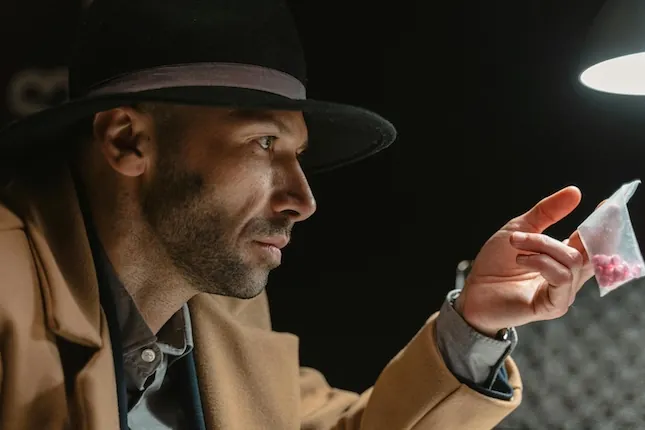Silent Witness: The Victim’s Influence on Mystery Plot and Character Dynamics

Every new mystery has a new victim. That victim is the fulcrum for setting up the mystery puzzle for your detective to solve. Your victim’s unique character and circumstances set the stage for your detective’s investigation.
Even though the victim is “off stage” for most of your story, if not all, to create a sound and intriguing puzzle, you need to know a lot about the victim. They are one of the key characters along with the villain and the detective in your mystery novel.
What you contribute to your victim’s character background will have a profound influence on knowing how to introduce clues, suspects, and head toward the reveal of the villain’s relationship with the victim.
What You Need to Know About Your Victim
A. Establish the Victim’s Background
Crafting a compelling victim starts with detailing their background. Think of your victim not just as a plot device, but as a fully realized character with their unique history and traits. Consider the following aspects while building their profile:
– Personal History: What is their past like? Know their childhood, education, and significant life events that shaped who they were.
– Unique Traits: What sets them apart? Identify quirks, habits, or skills that make the victim memorable and distinctive.
– Occupation and Hobbies: What did they do for a living? Include details about their job and passions. This can add layers to their personality and open up various narrative possibilities.
– Relationships and Social Status: Who were they connected to? Outline their family, friends, colleagues, and any social circles they were part of, which can intertwine with your list of suspects.
B. Role Before the Incident
Before the victim becomes the focal point of the mystery, they play a role in the story’s world. Establish this context clearly:
– Daily Life: Paint a picture of their day-to-day activities. What was their routine? This can make the sudden disruption of their death more impactful.
– Community Involvement: How active were they in their community? Whether they were social butterflies or reclusive individuals can influence the narrative.
– Character Traits* Highlight their personality traits. Were they kind-hearted, secretive, ambitious, or vengeful? These traits drive the plot forward and offer clues.
By meticulously developing the victim’s profile, you’re laying a robust foundation for your mystery. A well-defined victim provides a wealth of story opportunities, enriching the interplay between plot dynamics and character interactions, and ultimately drawing your readers deeper into the mystery.
The Victim’s Relationship with Suspects
A. Personal Ties
The victim’s relationships are pivotal in creating a web of intrigue and suspicion. By creating these connections, you can develop multiple layers of complexity in your story:
– Friends and Family: Outline the victim’s close relationships. Who were their trusted confidants? Family members, best friends, and romantic partners can all provide vital clues and suspects.
– Colleagues and Acquaintances: Look at their professional life. Who did they work with? Were there any workplace rivalries or friendships that might turn sour?
– Unresolved Conflicts: Identify any ongoing disagreements or past altercations. Old grudges or recent disputes can fuel motives for characters within the story.
B. Hidden Connections
Often, the most intriguing dimensions of a mystery come from relationships that are not immediately apparent:
– Secret Relationships: Did the victim have clandestine romances, illicit business dealings, or hidden friendships? Uncovering these links can surprise both the investigator and the readers.
– Double Life: Explore if the victim led a double life. Were they involved in activities or circles unknown to others, adding shock value and depth to the narrative?
– Unexpected Alliances: Sometimes, the victim’s allies might prove unexpected. Detect any alliances with characters who initially appear unconnected, to enrich the plot with twists.
C. Conflict and Motive
Understanding the victim’s dynamic with the suspects helps outline potential motives, heightening the suspense and complexity of the mystery:
– Financial Disputes: Consider any monetary issues the victim was involved in. Were there loans, debts, or financial competitions that might lead someone to commit a crime?
– Jealousy and Rivalry: Did the victim’s success or personal relationships evoke jealousy in others? Professional and personal rivalries can provide strong motives.
– Betrayal and Revenge: Sometimes the deepest motives come from feelings of betrayal. Explore any acts of deceit or treachery by the victim or towards them, and how these might provoke revenge.
By fleshing out how the victim relates to each suspect, you create a rich and engaging tapestry of interpersonal dynamics. Each suspect’s connection to the victim provides clues and deepens the reader’s engagement, as they sift through relationships and motives to unravel the mystery.
The Victim’s Link to the Villain
A. Direct Opponents or Unknowing Adversaries
The relationship between the victim and the villain is central to your mystery’s core conflict. Whether they are direct rivals or unsuspecting adversaries can shape pivotal plot points:
– Direct Confrontations: Were the victim and villain engaged in a visible conflict? Public arguments, competitive business ventures, or legal battles can set the stage for a high-stakes narrative.
– Unknown Threats: Sometimes, the victim may not be aware of the danger they posed to the villain. Unintended consequences of their actions, unknown threats to the villain’s plans, or hidden challenges to the villain’s power can create compelling tension.
B. History and Grudges
The past often plays a significant role in determining the motives and actions of characters within a mystery novel. Exploring historical grudges between the victim and villain can add depth:
– Long-standing Feuds: Examine if there were historical conflicts. Did the victim’s family have a feud with the villain’s? Multi-generational conflicts or long-lasting disputes can add rich backstory.
– Betrayals and Broken Trust: What past betrayals fueled the villain’s hatred? Broken trusts, romantic entanglements, or business treachery can all form potent motives.
– Past Encounters: Look into any significant past interactions between the victim and villain. Were there moments of conflict, alliance, or pivotal events that set the current events in motion?
C. Impact on Villain’s Psychology
Understanding how the victim’s life and death affect the villain’s psychology can provide incredible insight into their motives and actions, enriching the narrative:
– Emotional Reaction: How did the villain feel about the victim? Strong emotions such as love, jealousy, hatred, or obsession can drive a villain’s actions and add an emotional layer to the plot.
– Psychological Unraveling: The death of the victim might be a tipping point for the villain. Explore if this event triggers a psychological transformation, pushing the villain toward increasingly desperate or reckless actions.
– Rationalization and Justification: Dive into the villain’s mindset. How do they justify their actions? Understanding their rationale provides depth and nuance, making the villain a multidimensional character rather than a simple antagonist.
By crafting a nuanced and intricate connection between the victim and the villain, you enrich the plot and character development of your mystery novel. This relationship, full of complex interactions and backstory, fuels the narrative’s suspense and provides rich ground for twists and revelations.
Enhance the Plot Through Victim Development
A. Trigger the Investigation
The victim’s profile plays an essential role in setting off the investigative aspect of your storyline. Here’s how a well-developed victim can catalyze the investigation:
– Initial Discovery: How and where is the victim discovered? A compelling setup—whether it’s a dramatic public revelation or a quiet, hidden find—can immediately grab the reader’s attention and set the tone for the investigation.
– First Impressions: What do initial impressions of the victim reveal? Clues found on or around the victim, such as personal items, injuries, or location, can initiate multiple investigative threads.
– Personal Stakes: If the victim has close ties to the protagonist or investigator, this can add emotional depth and urgency to the investigation, driving the plot forward.
B. Building Suspense and Twists
A richly developed victim allows you to weave intricate details into the plot, creating opportunities for suspense and unexpected twists:
– Secret Lfve: Use aspects of the victim’s background to introduce unexpected developments. As layers of their life are peeled back, secrets can come to light, challenging initial assumptions and leading the story into new directions.
– Red Herrings: The victim’s complex background can be used to introduce misleading clues. Details that seem significant but lead to dead ends or further complications can keep readers guessing and maintain suspense.
– Hidden Motives: As the detective uncovers more about the victim, they may find hidden motives or connections that radically shift the direction of the plot, providing thrilling plot twists.
C. Emotional Engagement
Crafting a compelling victim profile ensures that readers become emotionally invested in the mystery:
– Empathy and Relatability: When the victim is a well-rounded character with relatable traits and experiences, readers are more likely to feel a sense of loss and urgency to find justice.
– Moral Complexity: A victim with flaws and complexities can evoke a range of emotional responses. Readers may experience conflicting feelings about the victim, adding depth to their engagement with the story.
– Personal Growth: The investigation into the victim’s life can also serve as a journey of personal growth for the protagonist, deepening the narrative by aligning the investigation with the protagonist’s personal stakes and motivations.
By enhancing the plot through the development of the victim, you create a multifaceted story that is not only compelling but also emotionally resonant. A well-developed victim character serves as the linchpin for suspense, twists, and emotional depth, ensuring that your mystery novel captivates readers and keeps them invested in the outcome.
Practical Tips for Writers
A. Research and Authenticity
Creating a believable and compelling victim involves thorough research and ensuring authenticity in your portrayal:
– Cultural and Societal Context: Understand the cultural and societal backdrop of your victim. Ensure their actions, beliefs, and circumstances are fitting for their background and the story’s setting.
– Realism in Details: Pay attention to the minutiae of the victim’s life. Details such as their profession, habits, and relationships should reflect real-world accuracy, lending credibility to your narrative.
– Expert Consultations: Consider consulting experts or individuals familiar with aspects of your victim’s life. Whether it’s a specific profession, social issue, or cultural practice, expert insights can add depth and authenticity.
B. Integrative Storytelling
Seamlessly weaving the victim’s background into the narrative enhances the story’s immersive quality:
– Gradual Revelation: Unfold the victim’s story piece by piece. Allow the protagonist and readers to discover key aspects of the victim’s life gradually, maintaining suspense and interest.
– Interconnected Clues: Integrate clues about the victim’s life into the plot. Each revelation should feel naturally connected to the story, encouraging readers to piece together the mystery.
– Flashbacks and Memories: Use flashbacks, diary entries, or memories of other characters to reveal details about the victim. These techniques can provide different perspectives and deepen the reader’s understanding.
C. Balancing Details
Provide enough details to create a vivid victim without overwhelming the main plot:
– Essential Information: Focus on details that directly impact the plot or character development. Avoid extraneous information that may distract from the main narrative.
– Character Consistency: Ensure that the details about the victim are consistent and serve a purpose. Each piece of information should contribute to a cohesive and believable character profile.
– Pacing and Timing: Consider the pacing of revealing details about the victim. Space out significant revelations to maintain reader engagement and build suspense.
By applying these practical tips, you can craft a well-rounded victim that enhances your mystery novel’s realism, narrative integration, and balance. This approach ensures that the victim’s character contributes meaningfully to the story, enriching the plot and deepening reader engagement.
Final Thoughts
The victim in a mystery novel is central to creating a compelling and immersive reading experience. By investing time in developing their background, relationships, and the impact of their life and death on the story, you can craft a multifaceted mystery that captivates readers from start to finish. A well-developed victim not only enriches the narrative but also provides a powerful anchor for your characters’ actions and the unfolding of your plot.
Ready to enhance your mystery writing skills and craft captivating stories? Join Zara Altair’s 12-session coaching program, Write A Killer Mystery, and unlock the secrets to creating a killer mystery that captivates readers from the first page to the last. Start your journey today.






